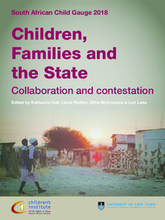This thirteenth issue of the South African Child Gauge® focuses on children in relation to families and the state, both of which are central to providing for children and supporting their development. The South African Child Gauge® is published annually by the Children’s Institute, University of Cape Town, to monitor progress towards realising children’s rights. This issue focuses on children, families and the state. This book features chapters reviewing recent developments in law and policy affecting children and others regarding children's household living arrangements, negotiating the care of children and support to caregivers, stopping family violence, and more.
PART ONE: Children and Law Reform Part one outlines recent legislative developments that affect the lives and rights of children. This issue comments on amendments to the Maintenance Act; bills before Parliament including the Traditional Courts Bill, draft Rates and Monetary Amounts Amendment Bill (VAT increase), and the Social Assistance Amendment Bill; draft amendments that have been published for comment, including amendments to the South African Schools Act, draft regulations on the Sexual Offences Courts and Children’s Third Amendment Bill; and reform processes that are still in the very early phases such as the draft Child Care and Protection Policy.
PART TWO: Children, Families and the State Part two presents nine essays that motivate for targeted and responsive policies, programmes and services that support families as they provide care and nurture children’s development. The first two essays motivate for recognizing the diversity and fluidity of families and caregiving relationships. Essays three and four outline the legal frameworks governing the rights of children and the roles and responsibilities of families and state. The next five essays motivate for: increasing support for parents and caregivers; adopting an integrated approach to stopping violence in families; targeting adequate income support for families; supporting families in the education, health and development of children; and building efficient referral mechanisms and responsive services for those in need.
PART THREE: Children Count – The numbers Part three updates a set of key indicators on children’s socio-economic rights and provides commentary on the extent to which these rights have been realised. The indicators are a select subset taken from the website www.childrencount.uct.ac.za.
Chapters include:

